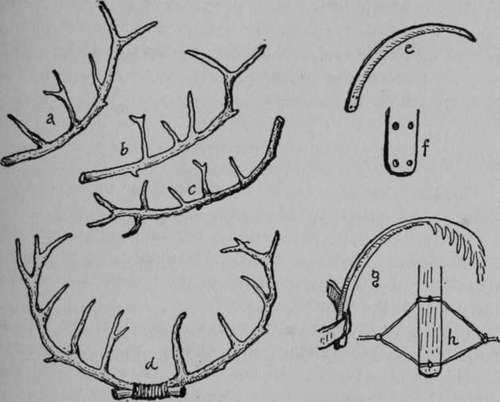The Caribou Dance
Description
This section is from the book "The Book Of Woodcraft", by Ernest Thompson Seton. Also available from Amazon: The Book of Woodcraft.
The Caribou Dance
The easiest of our campfire dances to learn, and the best for quick presentation, is the Caribou Dance. I have put it on for public performance, after twenty minutes' rehearsing, with fellows who never saw it before; and it does equally well for indoor gymnasium or for campfire in the woods.
In the way of fixings for this, you need four pairs of horns and four tails. I have seen real deer horns used, but they are scarce and heavy. It is better to go out where you can get a few crooked limbs of oak, cedar, hickory, or apple tree; and cut eight pair, as near like a, b, c, in the cut as possible, each about two feet long and one inch thick at the butt. Peel these; point the square ends of the branches, then lash them in pairs, thus (d). A pair, of course, is needed for each caribou. These are held in the hand and above the head, or in the hand resting on the head.

The tails are made each out of one third of a flat barrel hoop of wood. At one end of the hoop make four holes in pairs, an inch apart; thus (see f in cut). These are for cords that pass over the wearer's belt and through the hoop.
The hoop is then wrapped with white muslin and finished with a tuft of white muslin strips on the end. The tail finished, looks (g), and is stuck inside the wearer's belt, which goes through the two cord loops, (h,) shows a way of fastening on the tail with cord only.
The four caribou are best in white. Three or four hunters are needed. They should have bows but no arrows. The Medicine Man should have a drum and be able to sing the Mujje Mukesin, as given, or other Indian dance tune. One or two fellows who can howl like wolves should be sent off to one side, and another that can yell like a lynx or a panther on the other side, well away from the ring. Now we are ready for:
Continue to:
Tags
bookdome.com, books, online, free, old, antique, new, read, browse, download
